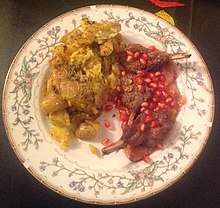Pomegranate
The pomegranate (Punica granatum) is a fruit-bearing deciduous shrub in the family Lythraceae, subfamily Punicoideae, that grows between 5 and 10 m (16 and 33 ft) tall.
.jpg)
| Pomegranate | |
|---|---|
.jpg) | |
| Fruit of Punica granatum split open to reveal the clusters of juicy, gem-like seeds on the inside, and a glass of juice | |
| Scientific classification | |
| Kingdom: | Plantae |
| Clade: | Tracheophytes |
| Clade: | Angiosperms |
| Clade: | Eudicots |
| Clade: | Rosids |
| Order: | Myrtales |
| Family: | Lythraceae |
| Genus: | Punica |
| Species: | P. granatum |
| Binomial name | |
| Punica granatum | |
| Synonyms | |
| |
The pomegranate originated in the region extending from Iran to northern India,[2] and has been cultivated since ancient times throughout the Mediterranean region. It was introduced into Spanish America in the late 16th century and into California by Spanish settlers in 1769.[2]
The fruit is typically in season in the Northern Hemisphere from September to February,[3] and in the Southern Hemisphere from March to May. As intact sarcotestas or juice, pomegranates are used in baking, cooking, juice blends, meal garnishes, smoothies, and alcoholic beverages, such as cocktails and wine.
Today, it is widely cultivated throughout the Middle East and Caucasus region, north and tropical Africa, the Indian subcontinent, Central Asia, the drier parts of Southeast Asia, and parts of the Mediterranean Basin.[2] It is also cultivated in parts of Arizona and the San Joaquin Valley in California.[4] In the 20th and 21st centuries, it has become more common in the shops and markets of Europe and the Western Hemisphere.[2][4]
Etymology
The name pomegranate derives from medieval Latin pōmum "apple" and grānātum "seeded".[5] Possibly stemming from the old French word for the fruit, pomme-grenade, the pomegranate was known in early English as "apple of Grenada"—a term which today survives only in heraldic blazons. This is a folk etymology, confusing the Latin granatus with the name of the Spanish city of Granada, which derives from Arabic.[6]
Garnet derives from Old French grenat by metathesis, from Medieval Latin granatum as used in a different meaning "of a dark red color". This derivation may have originated from pomum granatum, describing the color of pomegranate pulp, or from granum, referring to "red dye, cochineal".[7]
The French term for pomegranate, grenade, has given its name to the military grenade.[8]
Description
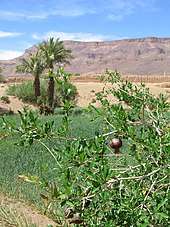
A shrub or small tree growing 5 to 10 m (16 to 33 ft) high, the pomegranate has multiple spiny branches and is extremely long-lived, with some specimens in France surviving for 200 years.[2] P. granatum leaves are opposite or subopposite, glossy, narrow oblong, entire, 3–7 cm (1 1⁄4–2 3⁄4 in) long and 2 cm (3⁄4 in) broad. The flowers are bright red and 3 cm (1 1⁄4 in) in diameter, with three to seven petals.[2] Some fruitless varieties are grown for the flowers alone.
Fruit, sarcotesta and seeds
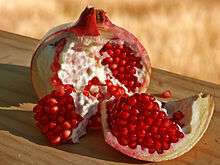
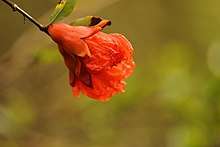

Red-purple in color, the pomegranate fruit husk has two parts: an outer, hard pericarp, and an inner, spongy mesocarp (white "albedo"), which comprises the fruit inner wall where seeds attach.[9] Membranes of the mesocarp are organized as nonsymmetrical chambers that contain seeds inside sarcotestas, which are embedded without attachment to the mesocarp.[9] Containing juice, the sarcotesta is formed as a thin membrane derived from the epidermal cells of the seeds.[10][11] The number of seeds in a pomegranate can vary from 200 to about 1,400.[12]
Botanically, the edible fruit is a berry with seeds and pulp produced from the ovary of a single flower.[10] The fruit is intermediate in size between a lemon and a grapefruit, 5–12 cm (2–4 1⁄2 in) in diameter with a rounded shape and thick, reddish husk.[2]
In mature fruits, the juice obtained by compressing the seeds yields a sour flavor due to low pH (4.4) and high contents of polyphenols,[13] which may cause a red indelible stain on fabrics.[14] Primarily, the pigmentation of pomegranate juice results from the presence of anthocyanins and ellagitannins.[13][15]
Cultivation
P. granatum is grown for its fruit crop, and as ornamental trees and shrubs in parks and gardens. Mature specimens can develop sculptural twisted-bark multiple trunks and a distinctive overall form. Pomegranates are drought-tolerant, and can be grown in dry areas with either a Mediterranean winter rainfall climate or in summer rainfall climates. In wetter areas, they can be prone to root decay from fungal diseases. They can be tolerant of moderate frost, down to about −12 °C (10 °F).[16]
Insect pests of the pomegranate can include the pomegranate butterfly Virachola isocrates and the leaf-footed bug Leptoglossus zonatus, and fruit flies and ants are attracted to unharvested ripe fruit.[17] Pomegranate grows easily from seed, but is commonly propagated from 25 to 50 cm (10 to 20 in) hardwood cuttings to avoid the genetic variation of seedlings. Air layering is also an option for propagation, but grafting fails.[2]
Varieties
P. granatum var. nana is a dwarf variety of P. granatum popularly planted as an ornamental plant in gardens and larger containers, and used as a bonsai specimen tree. It could well be a wild form with a distinct origin. It has gained the Royal Horticultural Society's Award of Garden Merit.[18][19]
The only other species in the genus Punica is the Socotran pomegranate (P. protopunica), which is endemic to the Socotraan archipelago of four islands located in the Arabian Sea, the largest island of which is also known as Socotra. The territory is part of Yemen. It differs in having pink (not red) flowers and smaller, less sweet fruit.[20]
Cultivars
P. granatum has more than 500 named cultivars, but evidently has considerable synonymy in which the same genotype is named differently across regions of the world.[9]
Several characteristics between pomegranate genotypes vary for identification, consumer preference, preferred use, and marketing, the most important of which are fruit size, exocarp color (ranging from yellow to purple, with pink and red most common), seed-coat color (ranging from white to red), hardness of seed, maturity, juice content and its acidity, sweetness, and astringency.[9]
History

The pomegranate is native to a region from modern-day Iran to northern India.[2] Pomegranates have been cultivated throughout the Middle East, South Asia, and Mediterranean region for several millennia, and it is also cultivated in the Central Valley of California and in Arizona.[2][21][22] Pomegranates may have been domesticated as early as the fifth millennium BC, as they were one of the first fruit trees to be domesticated in the eastern Mediterranean region.[23]
Carbonized exocarp of the fruit has been identified in early Bronze Age levels of Tell es-Sultan (Jericho) in the West Bank, as well as late Bronze Age levels of Hala Sultan Tekke on Cyprus and Tiryns.[24] A large, dry pomegranate was found in the tomb of Djehuty, the butler of Queen Hatshepsut in Egypt; Mesopotamian cuneiform records mention pomegranates from the mid-third millennium BC onwards.[25] Waterlogged pomegranate remains have been identified at the circa 14th century BC Uluburun shipwreck off the coast of Turkey.[26] Other goods on the ship include perfume, ivory and gold jewelry, suggesting that pomegranates at this time may have been considered a luxury good.[27] Other archaeological finds of pomegranate remains from the Late Bronze Age have been found primarily in elite residences, supporting this inference.[26]
It is also extensively grown in southern China and in Southeast Asia, whether originally spread along the route of the Silk Road or brought by sea traders. Kandahar is famous in Afghanistan for its high-quality pomegranates.[28]
Although not native to Korea or Japan, the pomegranate is widely grown there and many cultivars have been developed. It is widely used for bonsai because of its flowers and for the unusual twisted bark the older specimens can attain.[29] The term "balaustine" (Latin: balaustinus) is also used for a pomegranate-red color.[30]
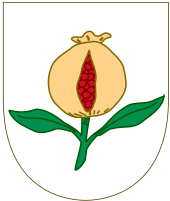
Spanish colonists later introduced the fruit to the Caribbean and America (Spanish America), but in the English colonies, it was less at home: "Don't use the pomegranate inhospitably, a stranger that has come so far to pay his respects to thee", the English Quaker Peter Collinson wrote to the botanizing John Bartram in Philadelphia, 1762. "Plant it against the side of thy house, nail it close to the wall. In this manner, it thrives wonderfully with us, and flowers beautifully, and bears fruit this hot year. I have twenty-four on one tree... Doctor Fothergill says, of all trees, this is most salutiferous to mankind."[31]

The pomegranate had been introduced as an exotic to England the previous century, by John Tradescant the Elder, but the disappointment that it did not set fruit there led to its repeated introduction to the American colonies, even New England. It succeeded in the South: Bartram received a barrel of pomegranates and oranges from a correspondent in Charleston, South Carolina, 1764. John Bartram partook of "delitious" pomegranates with Noble Jones at Wormsloe Plantation, near Savannah, Georgia, in September 1765. Thomas Jefferson planted pomegranates at Monticello in 1771; he had them from George Wythe of Williamsburg.[32]
Culinary use
After the pomegranate is opened by scoring it with a knife and breaking it open, the seeds are separated from the peel and internal white pulp membranes. Separating the seeds is easier in a bowl of water because the seeds sink and the inedible pulp floats. Freezing the entire fruit also makes it easier to separate. Another effective way of quickly harvesting the seeds is to cut the pomegranate in half, score each half of the exterior rind four to six times, hold the pomegranate half over a bowl, and smack the rind with a large spoon. The seeds should eject from the pomegranate directly into the bowl, leaving only a dozen or more deeply embedded seeds to remove.[33]
Pomegranate juice can be sweet or sour, but most fruits are moderate in taste, with sour notes from the acidic ellagitannins contained in the juice.[15] Pomegranate juice has long been a popular drink in Europe and the Middle East, and is now widely distributed in the United States and Canada.[34]
Grenadine syrup originally consisted of thickened and sweetened pomegranate juice,[35] now is usually a sales name for a syrup based on various berries, citric acid, and food coloring, mainly used in cocktail mixing.
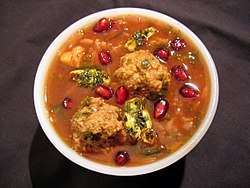
Before tomatoes (a New World fruit) arrived in the Middle East, pomegranate juice, molasses, and vinegar were widely used in many Iranian foods, and are still found in traditional recipes such as fesenjān, a thick sauce made from pomegranate juice and ground walnuts, usually spooned over duck or other poultry and rice, and in ash-e anar (pomegranate soup).[36][37]
Pomegranate seeds are used as a spice known as anar dana (from Persian: anar + dana, pomegranate + seed), most notably in Indian and Pakistani cuisine. Dried whole seeds can often be obtained in ethnic Indian markets. These seeds are separated from the flesh, dried for 10–15 days, and used as an acidic agent for chutney and curry preparation. Ground anardana is also used, which results in a deeper flavoring in dishes and prevents the seeds from getting stuck in teeth. Seeds of the wild pomegranate variety known as daru from the Himalayas are regarded as high quality sources for this spice.
Dried pomegranate seeds, found in some natural specialty food markets, still contain some residual water, maintaining a natural sweet and tart flavor. Dried seeds can be used in several culinary applications, such as trail mix, granola bars, or as a topping for salad, yogurt, or ice cream.
In the Caucasus, pomegranate is used mainly for juice.[38] In Azerbaijan, a sauce from pomegranate juice narsharab, (from Persian: (a)nar + sharab, lit. "pomegranate wine") is usually served with fish[39] or tika kabab.
In Turkey, pomegranate sauce (Turkish: nar ekşisi) is used as a salad dressing, to marinate meat, or simply to drink straight. Pomegranate seeds are also used in salads and sometimes as garnish for desserts such as güllaç.[40] Pomegranate syrup or molasses is used in muhammara, a roasted red pepper, walnut, and garlic spread popular in Syria and Turkey.[41]
In Greece, pomegranate is used in many recipes, including kollivozoumi, a creamy broth made from boiled wheat, pomegranates, and raisins, legume salad with wheat and pomegranate, traditional Middle Eastern lamb kebabs with pomegranate glaze, pomegranate eggplant relish, and avocado-pomegranate dip. Pomegranate is also made into a liqueur, and as a popular fruit confectionery used as ice cream topping, mixed with yogurt, or spread as jam on toast.
In Mexico, they are commonly used to adorn the traditional dish chiles en nogada, representing the red of the Mexican flag in the dish which evokes the green (poblano pepper), white (nogada sauce) and red (pomegranate seeds) tricolor.
In folk medicine
In India's ancient Ayurveda system of folk medicine, the pomegranate is frequently described as an ingredient in remedies.[42]
Nutrition
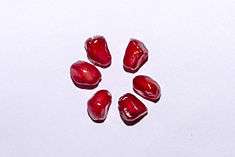 Pomegranate seeds | |
| Nutritional value per 100 g (3.5 oz) | |
|---|---|
| Energy | 346 kJ (83 kcal) |
18.7 g | |
| Sugars | 13.67 g |
| Dietary fiber | 4 g |
1.17 g | |
1.67 g | |
| Vitamins | Quantity %DV† |
| Thiamine (B1) | 6% 0.067 mg |
| Riboflavin (B2) | 4% 0.053 mg |
| Niacin (B3) | 2% 0.293 mg |
| Pantothenic acid (B5) | 8% 0.377 mg |
| Vitamin B6 | 6% 0.075 mg |
| Folate (B9) | 10% 38 μg |
| Choline | 2% 7.6 mg |
| Vitamin C | 12% 10.2 mg |
| Vitamin E | 4% 0.6 mg |
| Vitamin K | 16% 16.4 μg |
| Minerals | Quantity %DV† |
| Calcium | 1% 10 mg |
| Iron | 2% 0.3 mg |
| Magnesium | 3% 12 mg |
| Manganese | 6% 0.119 mg |
| Phosphorus | 5% 36 mg |
| Potassium | 5% 236 mg |
| Sodium | 0% 3 mg |
| Zinc | 4% 0.35 mg |
| |
| †Percentages are roughly approximated using US recommendations for adults. Source: USDA Nutrient Database | |
A 100 g (3.5 oz) serving of pomegranate sarcotesta provides 12% of the Daily Value (DV) for vitamin C, 16% DV for vitamin K, and 10% DV for folate (table).
Pomegranate seeds are a rich source of dietary fiber (20% DV) which is entirely contained in the edible seeds.[43]
Research
Phytochemicals
The most abundant phytochemicals in pomegranate juice are polyphenols, including the hydrolyzable tannins called ellagitannins formed when ellagic acid and gallic acid bind with a carbohydrate to form pomegranate ellagitannins, also known as punicalagins.[15] The red color of the juice is attributed to anthocyanins,[15] such as delphinidin, cyanidin, and pelargonidin glycosides.[44] Generally, an increase in juice pigmentation occurs during fruit ripening.[44] The phenolic content of pomegranate juice is degraded by processing and pasteurization techniques.[45]
Pomegranate peel contains high amount of polyphenols, condensed tannins, catechins, and prodelphinidins.[46][47] The higher phenolic content of the peel yields extracts for use in dietary supplements and food preservatives.[48]
Pomegranate seed oil contains punicic acid (65%), palmitic acid (5%), stearic acid (2%), oleic acid (6%), and linoleic acid (7%).[49]
Health claims
Despite limited research data, manufacturers and marketers of pomegranate juice have liberally used results from preliminary research to promote products.[50] In February 2010, the FDA issued a Warning Letter to one such manufacturer, POM Wonderful, for using published literature to make illegal claims of unproven antidisease benefits.[51][52][53] In May 2016, the US Federal Trade Commission declared that POM Wonderful cannot make health claims in its advertising, followed by a U.S. Supreme Court ruling that declined POM Wonderful's request to review the court ruling, upholding the FTC decision.[54][55]
Symbolism
Ancient Egypt
Ancient Egyptians regarded the pomegranate as a symbol of prosperity and ambition. It was referred to by the Semitic names of jnhm or nhm.[56] According to the Ebers Papyrus, one of the oldest medical writings from around 1500 BC, Egyptians used the pomegranate for treatment of tapeworm and other infections.[57]
Ancient and Modern Greece
The Greeks were familiar with the fruit far before it was introduced to Rome via Carthage, and it figures in multiple myths and artworks.[58] In Ancient Greek mythology, the pomegranate was known as the "fruit of the dead", and believed to have sprung from the blood of Adonis.[57][59]
The myth of Persephone, the goddess of the underworld, prominently features her consumption of pomegranate seeds, requiring her to spend a certain number of months in the underworld every year. The number of seeds and therefore months varies. During the months, while Persephone sits on the throne of the underworld beside her husband Hades, her mother Demeter mourned and no longer gave fertility to the earth. This was an ancient Greek explanation for the seasons.[60]
According to Carl A. P. Ruck and Danny Staples, the chambered pomegranate is also a surrogate for the poppy's narcotic capsule, with its comparable shape and chambered interior.[61] On a Mycenaean seal illustrated in Joseph Campbell's Occidental Mythology (1964), figure 19, the seated Goddess of the double-headed axe (the labrys) offers three poppy pods in her right hand and supports her breast with her left. She embodies both aspects of the dual goddess, life-giving and death-dealing at once.
The Titan Orion was represented as "marrying" Side, a name that in Boeotia means "pomegranate", thus consecrating the primal hunter to the goddess.
In the fifth century BC, Polycleitus took ivory and gold to sculpt the seated Argive Hera in her temple. She held a scepter in one hand and offered a pomegranate, like a "royal orb", in the other.[62] "About the pomegranate I must say nothing," whispered the traveller Pausanias in the second century, "for its story is somewhat of a holy mystery."[62] The pomegranate has a calyx shaped like a crown. In Jewish tradition, it has been seen as the original "design" for the proper crown.[63]
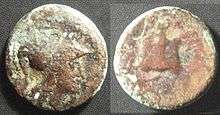
A pomegranate is displayed on coins from Side. The ancient Greek city of Side was in Pamphylia, a former region on the southern Mediterranean coast of Asia Minor (modern-day Antalya province, Turkey).[64]
Within the Heraion at the mouth of the Sele, near Paestum, Magna Graecia, is a chapel devoted to the Madonna del Granato, "Our Lady of the Pomegranate", "who by virtue of her epithet and the attribute of a pomegranate must be the Christian successor of the ancient Greek goddess Hera", observes the excavator of the Heraion of Samos, Helmut Kyrieleis.[65]

In modern times, the pomegranate still holds strong symbolic meanings for the Greeks. When one buys a new home, it is conventional for a house guest to bring as a first gift a pomegranate, which is placed under/near the ikonostasi (home altar) of the house, as a symbol of abundance, fertility, and good luck. When Greeks commemorate their dead, they make kollyva as offerings, which consist of boiled wheat, mixed with sugar and decorated with pomegranate. Pomegranate decorations for the home are very common in Greece and sold in most home goods stores.[66]
Ancient Israel and Judaism
The pomegranate is mentioned or alluded to in the Bible many times. It is also included in coinage and various types of ancient and modern cultural works.
For example, pomegranates were known in Ancient Israel as the fruits that the scouts brought to Moses to demonstrate the fertility of the "promised land".[67] The Book of Exodus[68] describes the me'il ("robe of the ephod") worn by the Hebrew high priest as having pomegranates embroidered on the hem, alternating with golden bells, which could be heard as the high priest entered and left the Holy of Holies. According to the Books of Kings,[69] the capitals of the two pillars (Jachin and Boaz) that stood in front of Solomon's Temple in Jerusalem were engraved with pomegranates. Solomon is said to have designed his coronet based on the pomegranate's "crown" (calyx).[63]
Some Jewish scholars believe the pomegranate was the forbidden fruit in the Garden of Eden.[70] Additionally, pomegranates are one of the Seven Species (Hebrew: שבעת המינים, Shiv'at Ha-Minim) of fruits and grains enumerated in the Hebrew Bible (Deuteronomy 8:8) as special products of the Land of Israel, and the Songs of Solomon contains this quote: "Thy lips are like a thread of scarlet, and thy speech is comely: thy temples are like a piece of a pomegranate within thy locks." (Song of Solomon 4:3).
Consuming pomegranates on Rosh Hashana is traditional because, with its numerous seeds, it symbolizes fruitfulness.[70] Also, it is said to have 613 seeds, which corresponds with the 613 commandments of the Torah, but it was a misconception.[71] This particular tradition is referred to in the opening pages of Ursula Dubosarsky's novel Theodora's Gift.[72]
The pomegranate appeared on the ancient coins of Judea, and when not in use, the handles of Torah scrolls are sometimes covered with decorative silver globes similar in shape to "pomegranates" (rimmonim).
Pomegranates symbolize the mystical experience in the Jewish mystical tradition, or kabbalah, with the typical reference being to entering the "garden of pomegranates" or pardes rimonim; this is also the title of a book by the 16th-century mystic Moses ben Jacob Cordovero.
In European Christian motifs

In the earliest incontrovertible appearance of Christ in a mosaic, a fourth-century floor mosaic from Hinton St Mary, Dorset, now in the British Museum, the bust of Christ and the chi rho are flanked by pomegranates.[73] Pomegranates continue to be a motif often found in Christian religious decoration. They are often woven into the fabric of vestments and liturgical hangings or wrought in metalwork. Pomegranates figure in many religious paintings by the likes of Sandro Botticelli and Leonardo da Vinci, often in the hands of the Virgin Mary or the infant Jesus. The fruit, broken or bursting open, is a symbol of the fullness of Jesus' suffering and resurrection.[70]
In the Eastern Orthodox Church, pomegranate seeds may be used in kolyva, a dish prepared for memorial services, as a symbol of the sweetness of the heavenly kingdom.
Armenia
The pomegranate is one of the main fruits in Armenian culture (alongside apricots and grapes). Its juice is used with Armenian food, heritage, or wine. The pomegranate is a symbol in Armenia, representing fertility, abundance, and marriage. It is also a semireligious icon. For example, the fruit played an integral role in a wedding custom widely practiced in ancient Armenia; a bride was given a pomegranate fruit, which she threw against a wall, breaking it into pieces. Scattered pomegranate seeds ensured the bride future children.
The Color of Pomegranates, a movie directed by Sergei Parajanov, is a biography of the Armenian ashug Sayat-Nova (King of Song) which attempts to reveal the poet's life visually and poetically rather than literally.[74]
Azerbaijan
The pomegranate is considered one of the symbols of Azerbaijan.[75] Annually in October, a cultural festival is held in Goychay, Azerbaijan known as the Goychay Pomegranate Festival. The festival features Azerbaijani fruit-cuisine mainly the pomegranates from Goychay, which is famous for its pomegranate growing industry. At the festival, a parade is held with traditional Azerbaijani dances and Azerbaijani music.[76] Pomegranate was depicted on the official logo of the 2015 European Games held in Azerbaijan.[77] Nar the Pomegranate was one of the two mascots of these games.[78] Pomegranates were also featured on the jackets worn by Azerbaijani male athletes at the games' opening ceremony.[79]
China

Introduced to China during the Han Dynasty (206 BC–220 AD), the pomegranate (Chinese: 石榴; pinyin: shíliu) in olden times was considered an emblem of fertility and numerous progeny. This symbolism is a pun on the Chinese character 子 (zǐ) which, as well as meaning seed, also means "offspring", thus a fruit containing so many seeds is a sign of fecundity. Pictures of the ripe fruit with the seeds bursting forth were often hung in homes to bestow fertility and bless the dwelling with numerous offspring, an important facet of traditional Chinese culture.[80]
India
In some Hindu traditions, the pomegranate (Hindi: anār) symbolizes prosperity and fertility, and is associated with both Bhoomidevi (the earth goddess) and Lord Ganesha (the one fond of the many-seeded fruit).[81][82]
Iran and ancient Persia
Iran is the second-largest producer and largest exporter of pomegranates in the world. In Persian, pomegranate is known as anar. The fruit's juice and paste have a role in Iranian cuisine, e.g. chicken, ghormas, and refreshment bars. Pomegranate skins may be used to stain wool and silk in the carpet industry.[83]
The Pomegranate Festival is an annual cultural and artistic festival held to exhibit and sell pomegranates, food products, and handicrafts.
Gallery
- Pomegranate blossom before petal fall
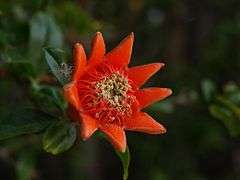
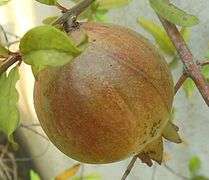 Unripened pomegranate fruit
Unripened pomegranate fruit Half peeled pomegranate
Half peeled pomegranate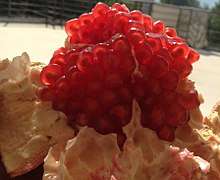 Fresh pomegranate seeds revealed through peeling
Fresh pomegranate seeds revealed through peeling
References
- "Punica granatum L., The Plant List, Version 1". Royal Botanic Gardens, Kew and Missouri Botanical Garden. 2010. Archived from the original on 11 August 2013. Retrieved 26 June 2015.
- Morton, J. F. (1987). "Pomegranate, Punica granatum L". Fruits of Warm Climates. Purdue New Crops Profile. pp. 352–5. Archived from the original on 21 June 2012. Retrieved 14 June 2012.
- "Pomegranate". Department of Plant Sciences, University of California at Davis, College of Agricultural & Environmental Sciences, Davis, CA. 2014. Archived from the original on 2 February 2017. Retrieved 29 January 2017.
- "Pomegranate". California Rare Fruit Growers. Archived from the original on 19 June 2012. Retrieved 14 June 2012.
- Harper, Douglas. "pomegranate". Online Etymology Dictionary.
- "All hail the Pomegranate, official symbol of Granada". The Lecrin Valley. 15 October 2012. Archived from the original on 9 June 2013. Retrieved 7 May 2020.
- Harper, Douglas. "garnet". Online Etymology Dictionary.
- Harper, Douglas. "grenade". Online Etymology Dictionary.
- Stover, E.; Mercure, E. W. (2007). "The Pomegranate: A New Look at the Fruit of Paradise". HortScience. 42 (5): 1088–1092. doi:10.21273/HORTSCI.42.5.1088.
- Holland, D.; Hatib, K.; Bar-Ya’akov, I. (2009). "Pomegranate: Botany, Horticulture, Breeding" (PDF). Horticultural Reviews. 35. Archived (PDF) from the original on 3 March 2016. Retrieved 19 November 2017.
- Dahlgren, R.; Thorne, R. F. (1984). "The order Myrtales: circumscription, variation, and relationships". Annals of the Missouri Botanical Garden. 71 (3): 633–699. doi:10.2307/2399158. JSTOR 2399158. Archived from the original on 12 October 2018. Retrieved 14 January 2018.
- "Does a larger pomegranate yield more seeds?". AquaPhoenix. Archived from the original on 4 November 2006. Retrieved 21 September 2006.
- Fernandes, L.; Pereira, J. A.; López Cortés, I.; Salazar, D. M.; Ramalhosa, E. C. (2015). "Physicochemical Changes and Antioxidant Activity of Juice, Skin, Pellicle and Seed of Pomegranate (cv. Mollar de Elche) at Different Stages of Ripening". Food Technology and Biotechnology. 53 (4): 397–406. doi:10.17113/ftb.53.04.15.3884. PMC 5079168. PMID 27904374.
- Jorgensen, SuzAnne; Brennand, Charlotte (June 2005). "Pomegranates" (PDF). Utah State University, Department of Food Safety. Archived from the original (PDF) on 12 September 2014. Retrieved 17 June 2017.
- Gómez Caravaca, A. M.; Verardo, V.; Toselli, M.; Segura Carretero, A.; Fernández Gutiérrez, A.; Caboni, M. F. (2013). "Determination of the major phenolic compounds in pomegranate juices by HPLC−DAD−ESI-MS". Journal of Agricultural and Food Chemistry. 61 (22): 5328–37. doi:10.1021/jf400684n. PMID 23656584.
- Ali Sarkhosh; Jeff Williamson (October 2018) [April 1994]. "The Pomegranate" (PDF). UF/IFAS Extension. Retrieved 7 May 2020.
- Ingels, Chuck; et al. (2007). The Home Orchard: Growing Your Own Deciduous Fruit and Nut Trees. University of California Agriculture and Natural Resources. p. 26.
- "Punica granatum var. nana". RHS Plant Selector. Royal Horticultural Society. Archived from the original on 15 May 2013. Retrieved 27 June 2013.
- "AGM Plants - Ornamental" (PDF). Royal Horticultural Society. March 2020. p. 90. Archived (PDF) from the original on 3 May 2020. Retrieved 7 May 2020.
- "Punica granatum - the Drops of Blood from Garden of Eden". Archived from the original on 23 January 2013.
- Doijode, S. D. (2001). Seed storage of horticultural crops. New York: Food Products Press. p. 77. ISBN 978-1-56022-883-7.
- George Ripley; Charles Anderson Dana (1875). The American cyclopaedia: a popular dictionary of general knowledge, Volume 13. Appleton.
... frequent reference is made to it in the Mosaic writings, and sculptured representations of the fruit are found on the ancient monuments of Egypt and in the Assyrian ruins. It is found in a truly wild state only in northern India ...
- Zohary, Daniel; Hopf, Maria; Weiss, Ehud (2012). Domestication of plants in the old world: The origin and spread of domesticated plants in south-west Asia (4th ed.). Oxford: Oxford University Press. pp. 114–115. ISBN 9780199549061.
- Still, D. W. (2006). "Pomegranate: A botanical perspective". In Seeram, Navindra P.; Schulman, Risa N.; Heber, David (eds.). Pomegranates: ancient roots to modern medicine. CRC Press. pp. 199–2010. ISBN 978-0-8493-9812-4.
- Hopf, Maria; Zohary, Daniel (2000). Domestication of plants in the old world: the origin and spread of cultivated plants in West Asia, Europe, and the Nile Valley (3rd ed.). Oxford [Oxfordshire]: Oxford University Press. p. 171. ISBN 978-0-19-850356-9.
- Ward, Cheryl (February 2003). "Pomegranates in eastern Mediterranean contexts during the Late Bronze Age". World Archaeology. 34 (3): 529–541. doi:10.1080/0043824021000026495. JSTOR 3560202.
- Ward Haldane, Cheryl (March 1990). "Shipwrecked plant remains". The Biblical Archaeologist. 53 (1): 55–60. doi:10.2307/3210160. JSTOR 3210160.
- "Pomegranate — Afghan Agriculture". afghanag.ucdavis.edu. University of California at Davis, International Programs. 2013. Archived from the original on 5 December 2016. Retrieved 17 February 2017.
- "History of Science: Cyclopædia, or, A universal dictionary of arts and sciences". Digicoll.library.wisc.edu. Archived from the original on 6 April 2012. Retrieved 14 June 2012.
- Osborne, Roy; Pavey, Don (2003). On Colours 1528: A Translation from Latin. Parkland, Fla: Universal Publishers. ISBN 978-1-58112-580-1.
- Leighton, Ann (1986). American gardens in the eighteenth century: "for use or for delight". Amherst: University of Massachusetts Press. p. 242. ISBN 978-0-87023-531-3.
- Leighton (1986), p. 272.
- "How to de-seed a pomegranate". Gourmet.com. 2008. Archived from the original on 14 May 2013.
- Tundel, Nikki (20 April 2007). "The pomegranate hits the peak of popularity". Minnesota Public Radio News. Archived from the original on 29 November 2014.
- Joseph Favre (1905). Dictionnaire Universel de Cuisine Pratique: Encyclopédie Illustrée D'Hygiène Alimentaire. Paris. p. 1088.
- Burke, Andrew (15 July 2008). Iran. Lonely Planet. p. 82. ISBN 978-1-74104-293-1. Retrieved 29 November 2010.
The anar (pomegranate) is native to the region around Iran and is eaten fresh and incorporated in a range of Persian dishes most famously in fesenjun, but also in ash-e-anar (pomegranate soup) and in rich red ab anar (pomegranate juice).
- "Ash-e Anar". Internetserver.com. Archived from the original on 11 February 2012. Retrieved 14 June 2012.
- Bulletin — Page 52 by United States Bureau of Plant Industry, Division of Plant Industry, Queensland
- Culinary cultures of Europe, Council of Europe, 2005, p. 72
- Akgün, Müge (22 September 2006). "Güllaç, a dainty and light dessert". Turkish Daily News. Istanbul: DYH. Archived from the original on 23 May 2008. Retrieved 26 December 2007.
- Malouf, Greg and Lucy (2006). Saha. Australia: Hardie Grant Books. p. 46. ISBN 978-0-7946-0490-5.
- K. K. Jindal; R. C. Sharma (2004). Recent trends in horticulture in the Himalayas. Indus Publishing. ISBN 978-81-7387-162-7.
... bark of tree and rind of fruit is commonly used in ayurveda ... also used for dyeing ...
- Nutrition data for raw pomegranate Archived 2013-03-30 at the Wayback Machine, Nutritiondata.com
- Hernández F, Melgarejo P, Tomás-Barberán FA, Artés F (1999). "Evolution of juice anthocyanins during ripening of new selected pomegranate (Punica granatum) clones". European Food Research and Technology. 210 (1): 39–42. doi:10.1007/s002170050529.
- Alper, N; Bahceci, KS; Acar, J (2005). "Influence of processing and pasteurization on color values and total phenolic compounds of pomegranate juice". Journal of Food Processing and Preservation. 29 (5–6): 357–368. doi:10.1111/j.1745-4549.2005.00033.x. ISSN 0145-8892.
- Nasr, C. Ben (1996). "Quantitative determination of the polyphenolic content of pomegranate peel". Zeitschrift für Lebensmittel-Untersuchung und Forschung. 203: 374–378. doi:10.1007/BF01231077.
- Plumb GW, De Pascual-Teresa S, Santos-Buelga C, Rivas-Gonzalo JC, Williamson G (2002). "Antioxidant properties of gallocatechin and prodelphinidins from pomegranate peel". Redox Rep. 7 (41): 41–6. doi:10.1179/135100002125000172. hdl:10261/97986. PMID 11981454.
- Li, Y.; Guo, C.; Yang, J.; Wei, J.; Xu, J.; Cheng, S. (2006). "Evaluation of antioxidant properties of pomegranate peel extract in comparison with pomegranate pulp extract". Food Chemistry. 96 (2): 254–260. doi:10.1016/j.foodchem.2005.02.033.
- Schubert, Shay Yehoshua; Lansky, Ephraim Philip; Neeman, Ishak (July 1999). "Antioxidant and eicosanoid enzyme inhibition properties of pomegranate seed oil and fermented juice flavonoids". Journal of Ethnopharmacology. 66 (1): 11–17. doi:10.1016/S0378-8741(98)00222-0. PMID 10432202.
- "Pomegranate: superfood or fad?". UK National Health Service (NHS). 26 April 2018. Archived from the original on 28 March 2016.
- "Pom Wonderful Warning Letter". U.S. Food and Drug Administration. Archived from the original on 24 April 2011. Retrieved 24 March 2011.
- "Understanding Front-of-Package Violations: Why Warning Letters Are Sent to Industry". Archived from the original on 19 March 2011. Retrieved 24 March 2011.
- Starling S (3 March 2010). "FDA says Pom Wonderful antioxidant claims not so wonderful". NutraIngredients.com. Retrieved 6 March 2010.
- "Statement of FTC Chairwoman Edith Ramirez Regarding Supreme Court's Decision Not to Review POM Wonderful Case". Bureau of Consumer Protection, US Federal Trade Commission. 2 May 2016. Archived from the original on 18 May 2017. Retrieved 18 July 2017.
I am pleased that the POM Wonderful case has been brought to a successful conclusion. The outcome of this case makes clear that companies like POM making serious health claims about food and nutritional supplement products must have rigorous scientific evidence to back them up. Consumers deserve no less.
- Sorvino, Chloe (2 May 2016). "The Verdict: POM Wonderful Misled Its Customers, A Blow To Its Billionaire Owners". Forbes. Archived from the original on 18 May 2017. Retrieved 18 July 2017.
- "Pomegranate". reshafim.org.il. Archived from the original on 25 February 2016. Retrieved 21 October 2017.
- Jayaprakasha, G. K.; Negi, P.S.; Jena, B.S. (2006). "Antimicrobial activities of pomegranate". In Seeram, Navindra P.; Schulman, Risa N.; Heber, David (eds.). Pomegranates: ancient roots to modern medicine. CRC Press. p. 168. ISBN 978-0-8493-9812-4.
- Hodgson, Robert Williard (1917). The pomegranate. Issue 276 of Bulletin. California Agricultural Experiment Station. p. 165. Archived from the original on 3 May 2016.
- Graves, Robert (1992). The Greek Myths. Penguin Books. p. 95. ISBN 978-0-14-017199-0.
- Ovid. Metamorphoses. V. pp. 385–571.
- Staples, Danny; Ruck, Carl A. P. (1994). The world of classical myth: gods and goddesses, heroines and heroes. Durham, N.C.: Carolina Academic Press. ISBN 978-0-89089-575-7.
- "Pausanias, Description of Greece". 2,17,4. Loeb Classical Library. Archived from the original on 3 December 2011. Retrieved 30 November 2011.
- Parashat Tetzaveh Archived 2006-08-22 at the Wayback Machine, Commentary by Peninnah Schram, Congregation B'nai Jeshurun, New York
- Sear, David R. (1978). Greek coins and their values. London: Seaby. ISBN 978-0-900652-46-2.
- Kyrieleis, Helmut. "The Heraion at Samos" in Greek Sanctuaries: New Approaches, Nanno Marinatos and Robin Hägg, eds. 1993, p. 143.
- Christmas Traditions in Greece by folklorist Thornton B. Edwards
- Why Hebrew Goes from Right to Left: 201 Things You Never Knew about Judaism, Ronald H. Isaacs (Newark, 2008), page 129
- 28:33–34
- 7:13–22
- "A Pomegranate for All Religions" Archived 2008-05-21 at the Wayback Machine by Nancy Haught, Religious News Service
- "What's the Truth about ... Pomegranate Seeds?". Ou.org. 5 June 2008. Archived from the original on 11 September 2012. Retrieved 14 June 2012.
- Dubosarsky, Ursula. Theodora's Gift. Archived from the original on 7 February 2012. Retrieved 6 July 2012.
- Paul Stephenson, Constantine, Roman Emperor, Christian Victor, 2010:1 and fig. 1.
- Paley, Tony (7 October 2014). "The colour of pomegranates: a chance to savour a poetic masterpiece". The Guardian. Archived from the original on 29 May 2016.
- European Games goes Gaga, Azeris jeer Armenians Archived 2015-06-15 at the Wayback Machine. Times of India. 13 June 2015. Retrieved 1 September 2015.
- iguide.travel Archived 2011-10-06 at the Wayback Machine Goychay Activities: Pomegranate Festival
- Korram, Andy (17 June 2014). "The "European Games, Baku 2015" disclosed their official logo". en.mastaekwondo.com. Archived from the original on 1 July 2014. Retrieved 25 June 2014.
- "Baku 2015 European Games Unveils Official Mascots Jeyran And Nar". baku2015.com. Archived from the original on 28 November 2014. Retrieved 26 November 2014.
- Lucie Janik. Azerbaijan National Team Wears Scervino Archived 2015-09-17 at the Wayback Machine. WWD. 11 June 2015. Retrieved 1 September 2015.
- Doré S.J., Henry; Kennelly, S.J. (Translator), M. (1914). Researches into Chinese Superstitions. Tusewei Press, Shanghai. Vol V p. 722
- Suresh Chandra (1998). Encyclopaedia of Hindu Gods and Goddesses. Sarup & Sons. p. 39. ISBN 978-81-7625-039-9.
Bhumidevi (the earth goddess) … Attributes: … pomegranate …
- Vijaya Kumar (2006). Thousand Names of Ganesha. Sterling Publishers. ISBN 978-81-207-3007-6.
… Beejapoori … the pomegranate in His hand is symbolic of bounteous wealth, material as well as spiritual …
- "Pomegranate Festival kicks off in Tehran". en.tehran.ir. Archived from the original on 19 November 2017. Retrieved 9 May 2017.
Further reading
- Seeram, N. P.; Schulman, R. N.; Heber, D., eds. (2006). Pomegranates: Ancient Roots to Modern Medicine. CRC Press. ISBN 978-0-8493-9812-4.
- Amos Fawole, Olaniyi; Linus Opara, Umezuruike (2013). "Developmental changes in maturity indices of pomegranate fruit: A descriptive review". Sci. Hort. 159: 152–161. doi:10.1016/j.scienta.2013.05.016.
External links
| Wikispecies has information related to Punica granatum |



- Pomegranate - Trusted Health Information (MedlinePlus)
